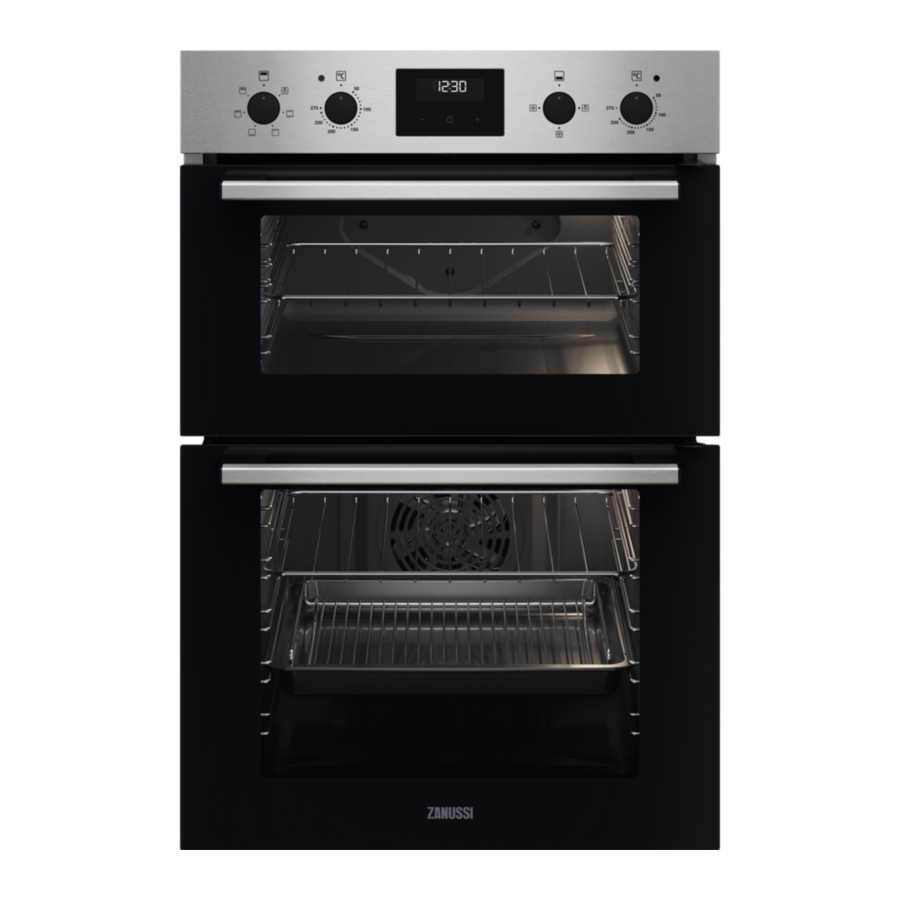
Zanussi ZKCXL3X1 - Electric Oven Manual
- User manual (25 pages) ,
- User manual (24 pages)
Advertisement

PRODUCT DESCRIPTION
General overview

- Knob for the top oven functions
- Knob for the top oven temperature
- Temperature indicator / symbol for the top oven
- Display
- Knob for the main oven functions
- Temperature indicator / symbol for the main oven
- Knob for the main oven temperature
- Heating element
- Lamp
- Fan
- Shelf support, removable
- Shelf positions
Accessories
- Wire shelf
For cookware, cake tins, roasts. - Grill- / Roasting pan
To bake and roast or as pan to collect fat. - Trivet
For roasting and grilling.

CONTROL PANEL
Retractable knobs
To use the appliance press the knob. The knob comes out.
Sensor fields / Buttons
 | To set the time. |
 | To set a clock function. |
 | To set the time. |
Display
The display works only with the main oven.
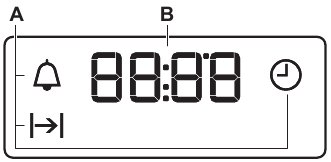
- Clock functions
- Timer
BEFORE FIRST USE
Refer to Safety chapters.
The oven can emit an odour and smoke during preheating. Make sure that the room is ventilated.
Preheat both ovens. Heat up one oven at a time.
 Step 1 |  Step 2 |  Step 3 |
| Set the clock | Clean the oven | Preheat the empty oven |
|
|
|
| Turn off the oven and wait until it is cold. Place the accessories and the removable shelf supports in the oven. | ||
DAILY USE
Refer to Safety chapters.
How to set: Heating function
- Turn the knob for the heating functions to select a heating function.
- Turn the control knob to select the tem‐ perature.
- When the cooking ends, turn the knobs to the off position to turn off the oven.
Top oven functions
| Heating function | Application |
 Light | To turn on the lamp. |
 Conventional Cooking | To bake and roast food on one shelf position. |
 Top Heat | To brown bread, cakes and pastries. To finish cooked dishes. |
 Bottom Heat | To bake cakes with crispy bottom and to preserve food. |
 Grill | To grill thin pieces of food and to toast bread. |
 Fast Grilling | To grill thin pieces of food in large quantities and to toast bread. |
Main oven functions
| Heating function | Application |
 Light | To turn on the lamp. |
 True Fan Cooking | To bake on up to two shelf positions at the same time and to dry food. Set the temperature 20 - 40°C lower than for Conventional Cooking. |
 Defrost | To defrost food (vegetables and fruit). The defrosting time depends on the amount and size of the frozen food. |
CLOCK FUNCTIONS
Clock functions
| Clock function | Application |
 Time of Day | To set, change or check the time of day. Only the top oven works without the set time. |
 Duration | To set how long the oven works. The function works only for the main oven. |
 Minute Minder | To set a countdown. This function has no effect on the operation of the oven. You can set this function at any time, also when the oven is off. |
How to set: Clock functions
How to set: Time of Day
 - flashes when you connect the oven to the electrical supply, when there was a power cut or when the timer is not set.
- flashes when you connect the oven to the electrical supply, when there was a power cut or when the timer is not set.
 - press to set the time.
- press to set the time.
After approximately 5 sec., the flashing stops and the display shows the time.
How to change: Time of Day
![]() press repeatedly to change the time of day.
press repeatedly to change the time of day. ![]() - starts to flash.
- starts to flash.![]() press to set the time.
press to set the time.
After approximately 5 sec., the flashing stops and the display shows the time.
How to set: Duration
- Set an oven function and the temperature.
![]() - press repeatedly.
- press repeatedly. ![]() - starts to flash.
- starts to flash.![]() - press to set the duration.
- press to set the duration.
The display shows:![]() .
.
![]() - flashes when the set time ends. The signal sounds and the oven turns off.
- flashes when the set time ends. The signal sounds and the oven turns off.- Press any button to stop the signal.
- Turn the knobs to the off position.
How to set: Minute Minder
![]() press repeatedly.
press repeatedly. ![]() - starts to flash.
- starts to flash.![]() press to set the time.
press to set the time.
The function starts automatically after 5 sec.
When the set time ends, the signal sounds.- Press any button to stop the signal.
- Turn the knobs to the off position.
How to cancel: Clock functions
![]() - press repeatedly until the clock function symbol starts to flash.
- press repeatedly until the clock function symbol starts to flash.- Press and hold:
![]() .
.
The clock function turns off after few seconds.
USING THE ACCESSORIES
Refer to Safety chapters.
Inserting accessories
A small indentation at the top increases safety. The indentations are also anti-tip devices. The high rim around the shelf prevents cookware from slipping of the shelf.
Wire shelf: Push the shelf between the guide bars of the shelf support.
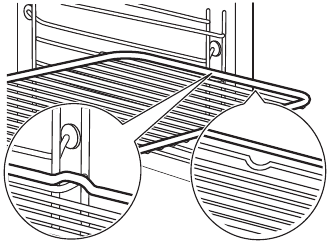
Deep pan: Push the tray between the guide bars of the shelf support.
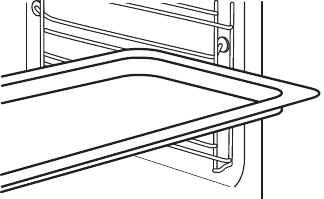
Trivet and Grill- / Roasting pan
- Put the trivet into a deep pan.
- Put the deep pan on the recommended shelf position.
Roasting larger pieces of meat or poultry on one shelf position.
Make sure the supports of the wire shelf point up.
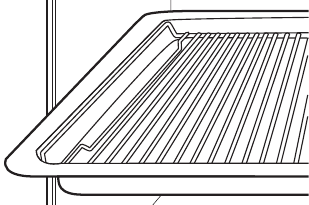
Grilling and toasting thin pieces of food in large quantities.
Make sure the supports of the wire shelf point down.
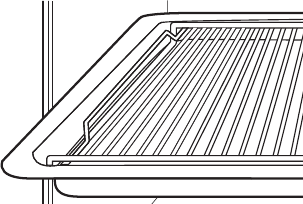
ADDITIONAL FUNCTIONS
Cooling fan
When the appliance operates, the cooling fan turns on automatically to keep the surfaces of the appliance cool. If you turn off the appliance, the cooling fan can continue to operate until the appliance cools down.
HINTS AND TIPS
Refer to Safety chapters.
Double oven
Top oven
The top oven is the smaller of the two ovens. It has 4 shelf positions. Use it to cook smaller quantities of food. It gives especially good results when used to cook fruitcakes, sweets and savoury flans or quiche.
Main oven
The main oven is the bigger of the two ovens. It is particularly suitable for cooking larger quantities of food.
Baking
For the first baking, use the lower temperature.
You can extend the baking time by 10 – 15 minutes if you bake cakes on more than one shelf position.
Cakes and pastries at different heights do not always brown equally. There is no need to change the temperature setting if an unequal browning occurs. The differences equalize during baking.
Trays in the oven can distort during baking. When the trays are cold again, the distortions disappear.
Tips on baking
| Baking results | Possible cause | Remedy | |
| The bottom of the cake is not baked sufficiently. | The shelf position is incorrect. | Put the cake on a lower shelf. | |
| The cake sinks and becomes soggy or streaky. | The oven temperature is too high. | Next time set slightly lower oven temperature. | |
| The oven temperature is too high and the baking time is too short. | Next time set a longer baking time and lower oven temperature. | ||
| The cake is too dry. | The oven temperature is too low. | Next time set higher oven temperature. | |
| The baking time is too long. | Next time set shorter baking time. | ||
| The cake bakes unevenly. | The oven temperature is too high and the baking time is too short. | Next time set a longer baking time and lower oven temperature. | |
| The cake batter is not evenly distributed. | Next time spread the cake batter evenly on the baking tray. | ||
| The cake is not ready in the baking time specified in a recipe. | The oven temperature is too low. | Next time set a slightly higher oven temperature. | |
Baking
Top oven
| Food | Temperature (°C) | Time (min) | Shelf position |
| Biscuits | 170 - 190 | 10 - 20 | 2 |
| Bread | 200 - 220 | 30 - 35 | 1 |
| Bread rolls / buns | 170-180 | 10 - 15 | 1 |
| Cakes: | |||
| 160 - 170 | 18 - 25 | 2 |
| 160 - 175 | 20 - 30 | 2 |
| 160 - 170 | 18 - 25 | 2 |
| 140 - 150 | 75 - 90 | 2 |
| 140 - 150 | 120 - 150 | 2 |
| 140 - 150 | 75 - 90 | 2 |
| 90 - 100 | 150 - 180 | 2 |
| 160 - 170 | 25 - 30 | 2 |
| 130 - 150 | 45 - 65 | 2 |
| Casseroles: | |||
| 160 - 170 | 150 - 180 | 1 |
| 160 - 180 | 75 - 90 | 1 |
| Fish | 170 - 190 | 20 - 30 | 2 |
| Fish Pie (Potato Topped) | 190 - 200 | 20 - 30 | 2 |
| Fruit Pies, Crumbles | 190 - 200 | 30 - 50 | 2 |
| Milk Puddings | 150 - 170 | 90 - 120 | 2 |
| Pasta, Lasagne etc. | 170 - 180 | 40 - 50 | 2 |
| Pastry: | |||
| 180 - 190 | 30 - 40 | 2 |
| 180 - 190 | 30 - 40 | 2 |
| 210 - 220 | 30 - 40 | 2 |
| Shortcrust: | |||
| 190 - 210 | 15 - 20 | 2 |
| 190 - 210 | 25 - 35 | 2 |
| 180 - 200 | 25 - 50 | 2 |
| Scones | 220 - 230 | 8 - 12 | 2 |
| Shepard's Pie | 180 - 190 | 30 - 40 | 2 |
| Souffles | 190 - 200 | 20 - 30 | 2 |
| Vegetables: | |||
| 180 - 190 | 60 - 90 | 2 |
| 180 - 190 | 60 - 90 | 2 |
| Yorkshire Pudding: | |||
| 200 - 210 | 25 - 40 | 1 |
| 210 - 220 | 15 - 25 | 1 |
Tips on Roasting
Use heat-resistant ovenware.
Roast lean meat covered (you can use aluminium foil).
Roast large meat joints directly in the tray.
Put some water in the tray to prevent dripping fat from burning.
Turn the roast after 1/2 - 2/3 of the cooking time.
Roast meat and fish in large pieces (1 kg or more).
If level one is suggested put the food directly on the baking tray
Baste meat joints with their own juice several times during roasting.
Grilling
Always grill with the maximum temperature setting.
Set the shelf into the shelf position as recommended in the grilling table.
For grilling in the top oven adjust the shelf position to suit different thicknesses of food.
Always set the pan to collect the fat into the first shelf position.
Grill only flat pieces of meat or fish.
Always preheat the empty oven with the grill functions for 5 minutes.
Always grill with the oven door closed.
Grilling and Fast Grilling - Top oven
| Food | Time (min) |
| Bacon Rashers | 5 -6 |
| Beefburgers | 10 - 20 |
| Chicken Joints | 20 - 40 |
| Lamb Chops | 15 - 25 |
| Pork Chops | 20 - 25 |
| Whole Fish, Trout / Makarel | 10 - 12 |
| Fillets, Plaice / Cod | 4 - 6 |
| Kebabs | 12 - 18 |
| Kidneys, Lamb / Pig | 6 - 10 |
| Sausages | 20 - 30 |
| Toasted Sandwiches | 3 - 4 |
| Steaks: | |
| 4 - 6 |
| 6 - 8 |
| 12 - 15 |
Defrost - Main oven
Remove the food packaging and put the food on a plate.
Use the first shelf position from the bottom.
Do not cover the food with a bowl or a plate, as this can extend the defrost time.
| Food | Quantity (kg) | Defrosting time (min) | Further defrosting time (min) | Comments |
| Chicken | 1 | 100 - 140 | 20 - 30 | Put the chicken on an upturned saucer in a big plate. Turn halfway through. |
| Meat | 1 | 100 - 140 | 20 - 30 | Turn halfway through. |
| Meat | 0.5 | 90 - 120 | 20 - 30 | Turn halfway through. |
| Trout | 0.15 | 25 - 35 | 10 - 15 | - |
| Strawberries | 0.3 | 30 - 40 | 10 - 20 | - |
| Butter | 0.25 | 30 - 40 | 10 - 15 | - |
| Cream | 2 x 0.2 | 80 - 100 | 10 - 15 | Whip the cream when still slightly frozen in places. |
| Gateau | 1.4 | 60 | 60 | - |
CARE AND CLEANING
Refer to Safety chapters.
Notes on cleaning
 Cleaning Agents | Clean the front of the appliance only with a microfibre cloth with warm water and a mild detergent. |
| Use a cleaning solution to clean metal surfaces. | |
| Clean stains with a mild detergent. Do not apply it on the catalytic surfaces. | |
 Everyday Use | Clean the cavity after each use. Fat accumulation or other residue may cause fire. |
| Do not store the food in the appliance for longer than 20 minutes. Dry the cavity only with a microfibre cloth after each use. | |
 Accessories | Clean all accessories after each use and let them dry. Use only a microfibre cloth with warm water and a mild detergent. Do not clean the accessories in a dishwasher. |
| Do not clean the non-stick accessories using abrasive cleaner or sharp-edged objects. |
How to remove: Shelf supports
Remove the shelf supports to clean the oven.
| Step 1 | Turn off the oven and wait until it is cold. |  |
| Step 2 | Pull the front of the shelf support away from the side wall. | |
| Step 3 | Pull the rear end of the shelf support away from the side wall and remove it. |  |
| Step 4 | Install the shelf supports in the opposite sequence. |
How to use: Catalytic cleaning
The cavity is coated with catalytic enamel. It absorbs fat during catalysis.
Spots or discolouration of the catalytic coating have no effect on the cleaning.
Clean one oven at a time.
Before the catalytic cleaning
Turn off the oven and wait until it is cold.
Remove all accessories and removable shelf supports.
Clean the oven floor and the inner door glass with warm water, soft cloth and mild detergent.
Clean the oven with catalytic cleaning
- To clean the top oven set the function:
![]() .
.
To clean the main oven set the function:![]() .
. - Set the maximum oven temperature. Duration: 1 h
- After cleaning, turn the knob for the oven functions to the off position.
- When the oven is cold, clean the cavity with a wet soft cloth.
How to remove and install: Door
You can remove the door and the internal glass panels to clean it. The number of glass panels is different for different models.
The door is heavy.
Carefully handle the glass, especially around the edges of the front panel. The glass can break.
| Step 1 | Fully open the door. |  |
| Step 2 | Lift and press the clamping levers (A) on the two door hinges. | |
| Step 3 | Close the oven door to the first opening position (approximately 45° angle). Hold the door with one hand on each side and pull it away from the oven at an upwards angle. Put the door with the outer side down on a soft cloth on a stable surface. |  |
| Step 4 | Hold the door trim (B) on the top edge of the door at the two sides and push inwards to release the clip seal. |  |
| Step 5 | Pull the door trim to the front to re‐ move it. | |
| Step 6 | Hold the door glass panels on their top edge one by one and pull them up out of the guide. | |
| Step 7 | Clean the glass panel with water and soap. Dry the glass panel care‐ fully. Do not clean the glass panels in the dishwasher. |  |
| Step 8 | After cleaning, do the above steps in the opposite sequence. | |
| Step 9 | Install the smaller panel first, then the larger and the door. Make sure that the glasses are inserted in the correct position otherwise the surface of the door may overheat. | |
How to replace: Lamp
Risk of electric shock.
The lamp can be hot.
Before you replace the lamp:
- Turn off the oven. Wait until the oven is cold.
- Disconnect the oven from the mains.
- Put a cloth on the bottom of the cavity.
Back lamp
- Turn the glass cover to remove it.
- Clean the glass cover.
- Replace the lamp with a suitable 300°C heat-resistant lamp.
- Install the glass cover.
TROUBLESHOOTING
Refer to Safety chapters.
What to do if
In any cases not included in this table please contact with an Authorised Service Centre.
| Problem | Check if... |
| The oven does not heat up. | The fuse is blown. |
| The display shows "12.00". | There was a power cut. Set the time of day. |
| The lamp does not work. | The lamp is burnt out. |
Service data
If you cannot find a solution to the problem yourself, contact your dealer or an Authorised Service Centre.
The necessary data for the service centre is on the rating plate. The rating plate is on the front frame of the appliance cavity. Do not remove the rating plate from the appliance cavity.
ENERGY EFFICIENCY
2 Electricity Built-In Oven 48.1 kg
| Supplier's name | Zanussi |
| Model identification | ZKCXL3X1 944171729 |
| Energy Efficiency Index | Top oven: 106.8 Main oven: 95.2 |
| Energy efficiency class | Top oven: A Main oven: A |
| Energy consumption with a standard load, conventional mode | Top oven: 0.78 kWh/cycle Main oven: not applicable |
| Energy consumption with a standard load, fan-forced mode | Top oven: - Main oven: 0.79 kWh/cycle |
| Number of cavities | 2 |
| Heat source | Electricity |
| Volume | Top oven: 42 l Main oven: 66 l |
| Type of oven | Built-In Oven |
| Mass | 48.1 kg |
Energy saving
The appliance has features which help you save energy during everyday cooking.
Make sure that the appliance door is closed when the appliance operates. Do not open the appliance door too often during cooking. Keep the door gasket clean and make sure it is well fixed in its position.
Use metal cookware to improve energy saving.
When possible, do not preheat the appliance before cooking.
Keep breaks between baking as short as possible when you prepare a few dishes at one time.
Cooking with fan
When possible, use the cooking functions with fan to save energy.
Residual heat
When the cooking duration is longer than 30 min, reduce the appliance temperature to minimum 3 - 10 min before the end of cooking. The residual heat inside the appliance will continue to cook.
Use the residual heat to warm up other dishes.
Keep food warm
Choose the lowest possible temperature setting to use residual heat and keep a meal warm.
SAFETY INFORMATION

Children and vulnerable people safety
- This appliance can be used by children aged from 8 years and above and persons with reduced physical, sensory or mental capabilities or lack of experience and knowledge if they have been given supervision or instruction concerning the use of the appliance in a safe way and understand the hazards involved. Children of less than 8 years of age and persons with very extensive and complex disabilities shall be kept away from the appliance unless continuously supervised.
- Children should be supervised to ensure that they do not play with the appliance.
- Keep all packaging away from children and dispose of it appropriately.
The appliance and its accessible parts become hot during use. Keep children and pets away from the appliance when in use and when cooling down.- If the appliance has a child safety device, it should be activated.
- Children shall not carry out cleaning and user maintenance of the appliance without supervision.
General Safety
- This appliance is for cooking purposes only.
- This appliance is designed for single household domestic use in an indoor environment.
- This appliance may be used in, offices, hotel guest rooms, bed & breakfast guest rooms, farm guest houses and other similar accommodation where such use does not exceed (average) domestic usage levels.
- Only a qualified person must install this appliance and replace the cable.
- Do not use the appliance before installing it in the built-in structure.
- Disconnect the appliance from the power supply before carrying out any maintenance.
- If the supply cord is damaged, it must be replaced by the manufacturer, its Authorised Service Centre or similarly qualified persons to avoid an electrical hazard.
- The means for disconnection must be incorporated in the fixed wiring in accordance with the wiring rules.
Ensure that the appliance is switched off before replacing the lamp to avoid the possibility of electric shock.
The appliance and its accessible parts become hot during use. Care should be taken to avoid touching heating elements or the surface of the appliance cavity.- Always use oven gloves to remove or insert accessories or ovenware.
- To remove the shelf supports first pull the front of the shelf support and then the rear end away from the side walls. Install the shelf supports in the opposite sequence.
- Do not use a steam cleaner to clean the appliance.
- Do not use harsh abrasive cleaners or sharp metal scrapers to clean the glass door since they can scratch the surface, which may result in shattering of the glass.
SAFETY INSTRUCTIONS
Installation
Only a qualified person must install this appliance.
- Remove all the packaging.
- Do not install or use a damaged appliance.
- Follow the installation instructions supplied with the appliance.
- Always take care when moving the appliance as it is heavy. Always use safety gloves and enclosed footwear.
- Do not pull the appliance by the handle.
- Install the appliance in a safe and suitable place that meets installation requirements.
- Keep the minimum distance from other appliances and units.
- Before mounting the appliance, check if the appliance door opens without restraint.
- The appliance is equipped with an electric cooling system. It must be operated with the electric power supply.
- The built-in unit must meet the stability requirements of DIN 68930.
| Cabinet minimum height (Cabinet under the worktop minimum height) | 875 mm |
| Cabinet width | 560-570 mm |
| Cabinet depth | 550 mm |
| Height of the front of the appliance | 888 mm |
| Height of the back of the appliance | 872 mm |
| Width of the front of the appliance | 594 mm |
| Width of the back of the appliance | 538 mm |
| Depth of the appliance | 568 mm |
| Built in depth of the appliance | 547 mm |
| Depth with open door | 858 mm |
| Ventilation opening minimum size. Opening placed on the bottom rear side | 560x20 mm |
| Mounting screws | 3.5x25 mm |
Electrical connection
Risk of fire and electric shock.
- All electrical connections should be made by a qualified electrician.
- The appliance must be earthed.
- Make sure that the parameters on the rating plate are compatible with the electrical ratings of the mains power supply.
- Always use a correctly installed shockproof socket.
- Do not use multi-plug adapters and extension cables.
- Make sure not to cause damage to the mains plug and to the mains cable. Should the mains cable need to be replaced, this must be carried out by our Authorised Service Centre.
- Do not let mains cables touch or come near the appliance door or the niche below the appliance, especially when it operates or the door is hot.
- The shock protection of live and insulated parts must be fastened in such a way that it cannot be removed without tools.
- Connect the mains plug to the mains socket only at the end of the installation. Make sure that there is access to the mains plug after the installation.
- If the mains socket is loose, do not connect the mains plug.
- Do not pull the mains cable to disconnect the appliance. Always pull the mains plug.
- Use only correct isolation devices: line protecting cut-outs, fuses (screw type fuses removed from the holder), earth leakage trips and contactors.
- The electrical installation must have an isolation device which lets you disconnect the appliance from the mains at all poles. The isolation device must have a contact opening width of minimum 3 mm.
- This appliance is supplied without a main plug and a main cable.
Use
Risk of injury, burns and electric shock or explosion.
- Do not change the specification of this appliance.
- Make sure that the ventilation openings are not blocked.
- Do not let the appliance stay unattended during operation.
- Deactivate the appliance after each use.
- Be careful when you open the appliance door while the appliance is in operation. Hot air can release.
- Do not operate the appliance with wet hands or when it has contact with water.
- Do not apply pressure on the open door.
- Do not use the appliance as a work surface or as a storage surface.
- Open the appliance door carefully. The use of ingredients with alcohol can cause a mixture of alcohol and air.
- Do not let sparks or open flames to come in contact with the appliance when you open the door.
- Do not put flammable products or items that are wet with flammable products in, near or on the appliance.
Risk of damage to the appliance.
- To prevent damage or discoloration to the enamel:
- do not put ovenware or other objects in the appliance directly on the bottom.
- do not put aluminium foil directly on the bottom of cavity of the appliance.
- do not put water directly into the hot appliance.
- do not keep moist dishes and food in the appliance after you finish the cooking.
- be careful when you remove or install the accessories.
- Discoloration of the enamel or stainless steel has no effect on the performance of the appliance.
- Use a deep pan for moist cakes. Fruit juices cause stains that can be permanent.
- Always cook with the appliance door closed.
- If the appliance is installed behind a furniture panel (e.g. a door) make sure the door is never closed when the appliance operates. Heat and moisture can build up behind a closed furniture panel and cause subsequent damage to the appliance, the housing unit or the floor. Do not close the furniture panel until the appliance has cooled down completely after use.
Care and cleaning
Risk of injury, fire, or damage to the appliance.
- Before maintenance, deactivate the appliance and disconnect the mains plug from the mains socket.
- Make sure the appliance is cold. There is the risk that the glass panels can break.
- Replace immediately the door glass panels when they are damaged. Contact the Authorised Service Centre.
- Be careful when you remove the door from the appliance. The door is heavy!
- Clean regularly the appliance to prevent the deterioration of the surface material.
- Clean the appliance with a moist soft cloth. Use only neutral detergents. Do not use abrasive products, abrasive cleaning pads, solvents or metal objects.
- If you use an oven spray, follow the safety instructions on its packaging.
- Do not clean the catalytic enamel with detergents.
Internal lighting
Risk of electric shock.
- Concerning the lamp(s) inside this product and spare part lamps sold separately:
These lamps are intended to withstand extreme physical conditions in household appliances, such as temperature, vibration, humidity, or are intended to signal information about the operational status of the appliance. They are not intended to be used in other applications and are not suitable for household room illumination. - This product contains a light source of energy efficiency class G.
- Use only lamps with the same specifications.
Service
- To repair the appliance contact the Authorised Service Centre.
- Use original spare parts only.
VISIT OUR WEBSITE TO:
Get usage advice, brochures, trouble shooter, service and repair information: www.zanussi.com/support
zanussi.com\register
zanussi.com

Documents / Resources
References
Download manual
Here you can download full pdf version of manual, it may contain additional safety instructions, warranty information, FCC rules, etc.
Advertisement

 - press to set the time.
- press to set the time. .
. .
. .
.


 .
. .
.


















Need help?
Do you have a question about the ZKCXL3X1 and is the answer not in the manual?
Questions and answers